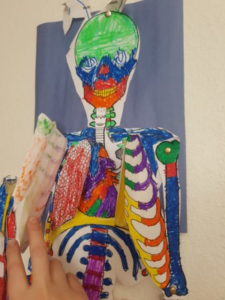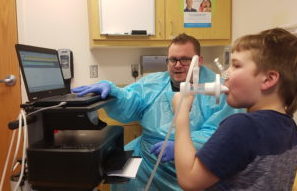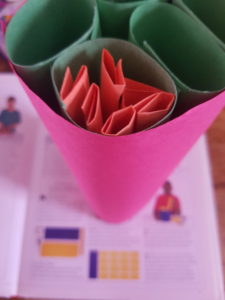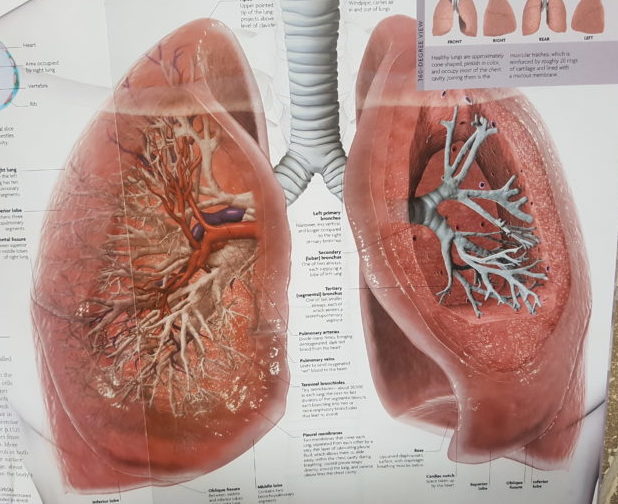Breathing. One of the most important things to keeping us alive!
The basic goals of this unit:
- Learn the parts of the respiratory system
- The nose and sinuses
- The Trachea and Vocal Cords
- The Lungs; Bronchi, Bronchioles, Alveoli, and Capillaries
- Cilia
- Rib Cage and Diaphragm
- Learn how the Respiratory System works with the Circulatory System
- Learn how to take a Respiration count
- Learn about some common respiratory illnesses and diseases
- Learn how to do rescue breaths, and about Positive Pressure Ventilation
- Learn how to treat a near-drowning
- Learn how to help a victim that is choking
- Learn about Asthma and how a rescue inhaler works
- Learn about Anaphylaxis and how to administer an epinephrine shot
- Review the 6 Vital Signs and their average readings
- Pulse, Respirations, Blood Pressure, Temperature, Skin, and AVPU
- Learn or continue Practicing CPR
- Continue Practicing EMT rapid exams, triage, placing a person in the recovery position, and treating patients with stress reaction shock
- Continue Practicing treatment for the various types of injury or illness previously studied
Our Reading Resources for The Respiratory System:
(Pictures of these books, more details about each, and some helpful links can be found on the Elementary First Responder Home Page.)
- The Riding the Respiratory System Chapter of “A Trip Through the Body;” pages 32-45
- The Respiratory System Chapter of “The Bones Book;” pages 36-39
- The Oxygen Supply section of Reader Digest’s “How the Body Works;” pages 69-77
- The Respiratory System Chapter in the Outward Bound book; pages 45-56
- The Near Drowning Chapter in the Outward Bound book; pages 159-161
- The Anaphylaxis Chapter in the Outward Bound book; pages 134-6
- The Respiratory System chapter of “The Human Body Book” by Parker pages 148-161
- The Artificial Breaths, Choking, Near Drowning, Asthma, and Anaphylaxis sections of of your preferred 1st Aid book. (We have a Boy Scout 1st Aid handbook, a Pediatric First Aid student guide, and the John Hopkins First Aid for Children Fast book)
- CPR sections of your 1st Aid book, if doing CPR with this Unit.
- SOAP study #5 ‘Distress, Portaging,’ #7 ‘Failure to Roll, Kayaking,’ #20 ‘Sting, Rafting,’ #24/26 ‘Broach, Canoeing’ and #30/34 ‘Lightning Strike’ in the Wilderness Medicine Workbook (depending on which edition you have; fifth or sixth)
- Specifically for CF Lung Learning:
- ‘Go Lungs’ by Stephanie East
- 2 ‘Medikids Explain Cystic Fibrosis’ Graphic Novels
- ‘Mallory’s 65 Roses’ by Diane Shader Smith
- We also looked over the Oral Airway and Nasal Airway section of Fundamentals of Firefighting Skills (Pages 757-8) but you can just google ‘Oropharyngeal Airway’ and ‘Nasopharyngeal Airway.’ This is more specific to EMT and above responding levels, but is so common in the field it’s worth an introduction.
Some Hands-On Activities and Field Trip Ideas
- The Respiratory System activity pages in Scholastic’s “The Body Book”
- The experiments in the Respiratory System Section of Reader Digest’s “How the Body Works“
- The Lungs projects in Scholastic’s “Make it Work Body”
- Visit a fire station or ambulance to learn about the many tools they use in assisting patients with a variety of breathing troubles.
- Dissect an animal lung. Ask a local hunter or your butcher shop for a specimen.
- Use a stethoscope to listen to you own and other’s respirations. Practice counting them.
- Practice caring for an unconscious victim using rescue breaths.
- Practice CPR on your own dummy.
- OR Visit a CPR training classroom.
- AND/OR Get your CPR certification.
- Practice the Heimlich and choking protocols.
- Continue adding to the Personal First Responder Training and Review Book:
- A diagram of the respiratory system; nose, trachea, and lungs
- Symptom and treatment plan pages for near drowning, anaphylaxis, asthma
- Symptom and treatment plan pages for upper airway obstruction, lower airway constriction, pulmonary edema, respiratory arrest, and chest trauma
So how did it go for us?!
 There seemed to be a lot of reading to go with this unit, particularly in the Outward Bound Book, but we found it very interesting. For Nathan, in particular, learning about he lungs is very personal, as his having Cystic Fibrosis means he spends 2 hours a day doing breathing treatments just to keep his lungs in a normal functioning state. To have a deeper understanding of how the lungs work, and more specifically how his lungs are particularly challenged helps him cope with the fact that he has to do so many treatments. Knowing the ‘why’ of a requirement is sometimes more important than obliging obedience.
There seemed to be a lot of reading to go with this unit, particularly in the Outward Bound Book, but we found it very interesting. For Nathan, in particular, learning about he lungs is very personal, as his having Cystic Fibrosis means he spends 2 hours a day doing breathing treatments just to keep his lungs in a normal functioning state. To have a deeper understanding of how the lungs work, and more specifically how his lungs are particularly challenged helps him cope with the fact that he has to do so many treatments. Knowing the ‘why’ of a requirement is sometimes more important than obliging obedience.

Mr. Nathan gets a CT Scan of his sinuses.
As with the previous ones, we did the reading for this unit in 30 minute sessions (with plenty of discussion) while I did manual CPT. We also did a few projects, including updating our paper skeleton with a heart and lungs, and learning the math behind surface area with another paper craft. We’re going to do the bottle top balloon diaphragm experiment as soon as I get around to purchasing the right size balloons, but each of these projects are really easy and relatively quick to pull off.

Nathan Performing a PFT
We have already visited a fire station to check out the medical supplies with the last unit, wrongly thinking it was going to be more blood and wound related, but we have future plans to visit the particular station here in Anchorage (#4) that restocks the ambulances and with that we will be able to rediscover the many pieces of respiratory rescue equipment they carry.
As part of his care Nathan had a routine CF check-up where he did a Pulmonary Function Test. He also got a CT of his sinuses. Lastly CF related, and ironic in it’s timing, we are in the process of getting him a vest for doing CPT, so there are plenty of life application activities going on to really flesh out our learning!

Learning about surface area within the alveoli
If you ask Nathan about this unit he’ll give you some generic answer about it being “fun” and “I liked it,” but the amount of discussion and problem solving I was receiving during our lecture/reading sessions really told me he was understanding the information on a very solid level.
With this unit Nathan also got some more specific CPR training from a professional. We discovered that, though he is quite strong, he really just does not have enough mass to truly perform CPR on a child, never-the-less an adult, so we’ll pursue and actual certification later. Perhaps even just a couple years if he still expresses interest. In the mean time though, we made a short video about our simple class. He even got to try out bag valve mask ventilation!


Post a comment